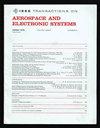星载MC-ScanSAR系统运动舰船径向速度估计方法
IF 5.7
2区 计算机科学
Q1 ENGINEERING, AEROSPACE
IEEE Transactions on Aerospace and Electronic Systems
Pub Date : 2024-12-11
DOI:10.1109/TAES.2024.3505114
引用次数: 0
摘要
方位与扫描模式相结合的多通道合成孔径雷达(MC-SAR)系统可以实现高分辨率和超宽波段SAR成像的要求。由于多通道扫描雷达(MC-ScanSAR)系统中目标的多普勒频谱不完整,且不同目标所占据的多普勒频谱范围不一致,传统的多普勒频谱分析方法无法对多通道扫描雷达(MC-ScanSAR)系统中舰船目标的径向速度进行估计,这给MC-ScanSAR舰船图像的应用带来了挑战。然而,移动船舶的速度在聚焦MC-ScanSAR图像中引入了额外的模糊目标,这不可避免地影响了船舶的解释和定位,但使其径向速度的估计成为可能。针对MC-ScanSAR单目复杂数据,提出了一种舰船径向速度估计方法。针对传统重构滤波器在运动目标信号成像过程中产生的重构失配问题,利用运动目标的模糊信号和主信号相关性,提出了一种高精度舰船径向速度估计算法。通过对点目标和海上舰船的仿真结果验证了该方法的有效性,结果表明在高海况条件下仍能保持较高的估计精度。本文章由计算机程序翻译,如有差异,请以英文原文为准。
A Radial Velocity Estimation Method of Moving Ships for Spaceborne MC-ScanSAR Systems
Multichannel synthetic aperture radar (MC-SAR) systems in azimuth combined with scanning mode can realize the requirements of high-resolution and ultrawide-swath SAR imaging. Since the Doppler spectrums of targets in ScanSAR are incomplete and the range of the Doppler spectrum occupied by different targets is inconsistent, the radial velocity estimation of ship targets in multichannel ScanSAR (MC-ScanSAR) systems cannot be performed based on the traditional Doppler spectrum analysis method, which poses a challenge of the application for the MC-ScanSAR ship images. However, the velocity of moving ships introduces additional ambiguous targets in focused MC-ScanSAR images, which inevitably affects the interpretation and localization of ships, but enables the estimation of its radial velocity. This article proposed a radial velocity estimation method of ship for MC-ScanSAR single-look complex data. Based on the reconstruction mismatch generated by conventional reconstruction filters in the imaging process for moving target signals, a high-accuracy radial velocity estimation algorithm for ships was proposed to utilize the ambiguous-signal and main-signal correlation of the moving targets. The proposed method is validated by simulation results on point targets and maritime ships, and the results show that the high estimation accuracy can still be maintained under high sea conditions.
求助全文
通过发布文献求助,成功后即可免费获取论文全文。
去求助
来源期刊
CiteScore
7.80
自引率
13.60%
发文量
433
审稿时长
8.7 months
期刊介绍:
IEEE Transactions on Aerospace and Electronic Systems focuses on the organization, design, development, integration, and operation of complex systems for space, air, ocean, or ground environment. These systems include, but are not limited to, navigation, avionics, spacecraft, aerospace power, radar, sonar, telemetry, defense, transportation, automated testing, and command and control.

 求助内容:
求助内容: 应助结果提醒方式:
应助结果提醒方式:


